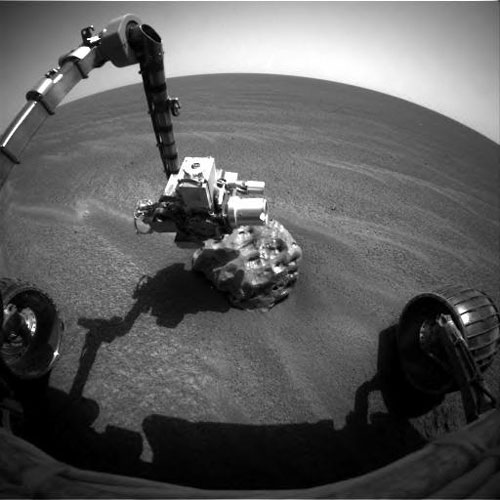Mars Rover Inspects Intriguing Rock – A Meteorite?

Scientists controlling the Opportunity Mars rover are taking an up-close look at an intriguing pitted rock on Mars, now dubbed "Heat Shield Rock".
A speculative view about the object is that the Mars robot has come across a meteorite. A detailed investigation of the rock is underway, work that should reveal the true nature of the object.
Wheeling about the open landscape of Meridiani Planum, Opportunity has been busily inspecting heat-shield wreckage -- hardware leftovers from the spacecraft's plummet to Mars in January of last year.
Completing one of several debris surveys, the robot turned and drove north toward Heat Shield Rock. The rover traversed about 33 feet (10 meters), parking itself at the desired standoff distance of about 3.3 feet (one meter) to acquire remote sensing of the rock.
Opportunity then acquired additional remote sensing, bumped forward closer to the rock, putting the odd object within the work volume of the tools mounted at the tip of the robot's mechanical arm.
Meteorite or "meteorwrong"?
Initial looks at the rock have stirred speculation the object could be a meteorite. Furthermore, Opportunity's Mini-Thermal Emission Spectrometer (Mini-TES) is suggestive that the find is made of metal.
Get the Space.com Newsletter
Breaking space news, the latest updates on rocket launches, skywatching events and more!
In wait-and-see mode is Steve Squyres of Cornell University, principal investigator for the science instruments onboard Opportunity, as well as the Spirit rover busy at work on the other side of Mars.
Squyres said data taken by Opportunity's Alpha Particle X-Ray Spectrometer -- a device that accurately determines the elements that make up rocks and soils - is to arrive over the weekend. So too is information about the rock from use of the rover's M?ssbauer Spectrometer. This equipment can determine the composition and abundance of iron-bearing minerals.
Too early to tell if it's a meteorite, said Laurie Leshin, Director of the Center for Meteorite Studies at Arizona State University in Tempe, Arizona.
"Not sure if it is or not, but it does sorta look like one," Leshin told SPACE.com. "Looks a lot like an iron [meteorite] to me."
Leshin said, however, that her Meteorite Center identifies loads of "meteorwrongs" per year. "Looks can be deceiving."
Given the robot's suite of science instruments, identifying the makeup and origin of the rock should be forthcoming.
Questions to ponder
If Opportunity has come across a meteorite, a number of issues arise.
"To me it is interesting for several speculative reasons," Leshin said. First of all, depending on the size, it may indicate that it fell during the time of a thicker atmosphere, she said.
"But we haven't done the calculation yet. Things much bigger than it appears to be wouldn't be slowed down by today's thin atmosphere [on Mars], and thus they would make a crater rather than a 'soft landing'", Leshin explained.
Leshin also conjectured about the shiny nature of the rock. "Is it because...meteorites don't react with the atmosphere as on Earth or has it been sandblasted?" Lastly, iron metal is one of the most susceptible things to weathering/rust in the presence of water.
"Thus, a nicely preserved meteorite -- unless we're unlucky and it fell yesterday, which we would never know -- strongly supports the idea that current weathering rates [on Mars] are incredibly low," she said.
Whether or not Opportunity has come across a meteorite is yet to be determined. "I will say that we've lent a bunch of iron meteorites to the Mini-TES team to compare with it!"
- Mars Rovers: Special Report
Join our Space Forums to keep talking space on the latest missions, night sky and more! And if you have a news tip, correction or comment, let us know at: community@space.com.

Leonard David is an award-winning space journalist who has been reporting on space activities for more than 50 years. Currently writing as Space.com's Space Insider Columnist among his other projects, Leonard has authored numerous books on space exploration, Mars missions and more, with his latest being "Moon Rush: The New Space Race" published in 2019 by National Geographic. He also wrote "Mars: Our Future on the Red Planet" released in 2016 by National Geographic. Leonard has served as a correspondent for SpaceNews, Scientific American and Aerospace America for the AIAA. He has received many awards, including the first Ordway Award for Sustained Excellence in Spaceflight History in 2015 at the AAS Wernher von Braun Memorial Symposium. You can find out Leonard's latest project at his website and on Twitter.









